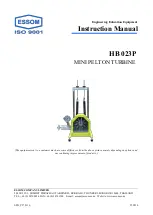
V 01-2017
www.superwind.com
22
composed of a cylinder pin 3 mm OD x 40 mm which is shown in the drawing in Graphic
7.2.2.3 on page 30.
6.3.3 Polarity
Always pay attention to the correct polarity
of the lines. Connecting to the batteries
with reversed polarity will destroy the
electric rectifier of your
Superwind
. In
general, you should mark all line ends by
POSITIVE (+) and NEGATIVE (-), in order
to prevent errors with the connection.
Marking of the connecting wires at the
Superwind
:
POSITIVE Line (+):
RED
NEGATIVE Line (-):
BLACK
The internal electric rectifier of the
Superwind
will be
destroyed by connecting the wires with reversed polarity. Loss
of warranty will result!
6.3.4 Batteries
6.3.4.1 Charging batteries
The most common use of the
Superwind
is charging batteries.
Our diversion charge regulator allows the Superwind operation to be
autonomous.
Autonomous operation allows the batteries to be brought to a full state of
charge (SOC) and still be protected against overcharging, resulting in
longer battery life and maintaining the battery manufacturer warranty.
When selecting batteries, pay particular attention to the correct rated
voltage (12 V or 24 V). The rated voltage of your
Superwind
is specified
on the yaw serial number label. (See Section 1 on Page No. 5).
Lead-acid batteries are most commonly used. The Superwind SCR
Charge regulators (Section 6.2 on Page No. 18) are suitable for all types
of batteries, although (depending on the battery manufacturing specs)
the charge controller may need to be adjusted to the battery
manufacturer recommendations. We recommend batteries designed for
stationary use (not starting batteries). Stationary or deep cycle batteries
are more suitable because they are designed for deeper discharge and
rapid recharge cycling, resulting in a longer service life.
Many deep cycle batteries are maintenance-free and better survive
occasional deep (below manufacturer’s recommended SOC) discharges
than do starter type batteries.
Car batteries (starting batteries) should be avoided as house span
batteries because they wear out very fast when exposed to the repeated
discharge/charging cycles that will normally occur in your system.
Содержание 350 12V
Страница 1: ...www superwind com Superwind 350 12V 24V Manual North Central and South America regions 01 2017...
Страница 2: ...V 01 2017 www superwind com 1 Page intentionally left blank...
Страница 52: ...V 01 2017 www superwind com 51 ATTACHMENT A Stop Switch Mounting Guidelines...
Страница 53: ...V 01 2017 www superwind com 52 STOP SWITCH Mounting Guidelines Manual 01 2017...
Страница 60: ...V 01 2017 www superwind com 59 ATTACHMENT B Superwind Charge Regulator 12V Marine...
Страница 61: ...V 01 2017 www superwind com 60 Charge Regulator 12V Marine Instructions Manual 01 2017...
Страница 70: ...V 01 2017 www superwind com 69 ATTACHMENT C Superwind Charge Regulator 24V Marine...
Страница 71: ...V 01 2017 www superwind com 70 Charge Regulator 24V Marine Instructions Manual...































